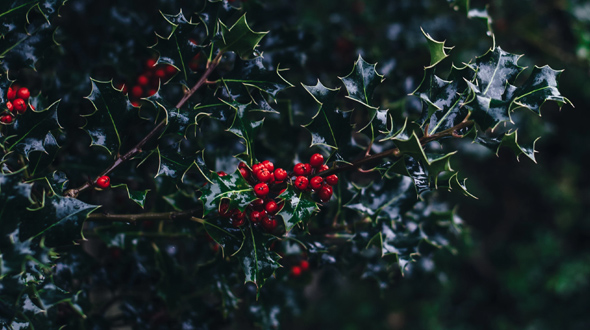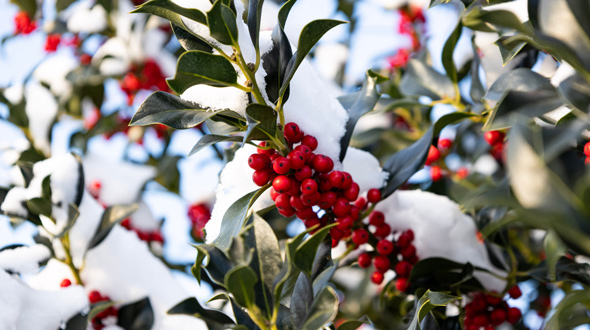Embellishing gardens and landscapes with their bright red berries and glossy green foliage, holly trees are a sight to behold. These trees, be they American holly, Chinese holly, or any other variety, are a testament to nature’s beauty. However, to ensure these plants continue to brighten our surroundings, they require nurturing care and attention. This guide will share expert tips and strategies for holly tree care, helping your trees and shrubs thrive and flourish.

Key Takeaways for Holly Plants
- Select the perfect spot for your holly tree by considering soil type, sun exposure, and mature size.
- Nurture your holly tree with regular watering, mulching, and fertilization in spring or early fall.
- Prune during dormancy to maintain shape while encouraging healthy growth. Companion plants can provide additional benefits such as pest repellent.
Selecting the Perfect Spot for Your Holly Tree
Choosing the perfect spot for your holly tree is the first step toward ensuring its healthy growth. Holly species, from the American holly to the English holly and the Chinese holly, all share common preferences regarding their planting site. They require well-draining, slightly acidic soil and prefer a location that receives full sun or partial shade.

The mature size and growth habits of the holly variety also play a significant role in selecting a suitable planting location. For instance, the ‘Jersey Delight’ holly tree, a type of American holly, can reach a height of 50 feet and a width of 40 feet when fully grown. Hence, selecting a location that can accommodate such dimensions becomes significantly important.
Soil Requirements
Holly trees, including various holly species, flourish in well-draining soil with a slightly acidic pH ranging between 5.0 and 7.0. To enhance soil drainage for holly trees, consider incorporating 10-20% horticultural grit or perlite into the soil mix and integrating organic material to improve soil structure. This will help maintain the overall health of the tree and prevent issues like dead or diseased branches.
If the soil in the selected location doesn’t naturally satisfy these desired conditions for holly trees, it should be supplemented with organic matter or an acidifying fertilizer. This will enhance drainage and acidity, which will help in producing bright red berries.
Sunlight and Shade
The amount of sunlight exposure a holly tree receives can significantly impact its growth and health. Holly trees generally thrive in full sun to partial shade; however, in hotter climates, they might find relief in afternoon shade to avoid the negative effects of excessive heat, which can impact the production of holly berries.
Holly trees require the following location and conditions to sustain their well-being and encourage optimal growth:
- A minimum of 4 hours of direct sunlight each day
- Both male and female holly plants in the vicinity to ensure the production of berries
- Protection from cold winds and intense winter sunlight to prevent dehydration and potential damage to the plant, including the female plant, which produces berries.
The Right Way to Plant Holly Tree Shrubs
Planting a holly tree goes beyond simply digging a hole and inserting the tree. The tree’s health and establishment hinge on the correct planting methods. Preparation of the planting hole and the soil is a vital step. Placing a layer of organic matter, such as compost or well-rotted manure, at the base of the hole will help enrich the soil and provide essential nutrients for the plant’s growth.

When planting a holly tree, it is important to ensure that it is planted at the same depth as it was initially growing, with the top of the roots level with the soil surface. This will help promote healthy and strong growth for the tree. Consideration should also be given to the spacing between holly plants. Holly plants should be spaced approximately 5 feet apart for small varieties or when establishing a hedge and up to 25 feet apart for larger tree-like varieties to provide sufficient space for growth.
Timing and Season
The growth and health of a holly tree largely depend on the timing of its planting. The most suitable time to plant American Holly is spring or early fall. Holly trees thrive in full sun to partial shade and require well-draining, loamy soil. Cooler weather, either before the onset of summer heat or as temperatures start to cool in the fall, is ideal for planting.
Temperature significantly influences the growth of holly trees. Here are some key points to keep in mind:
- Holly trees flourish in temperatures between 59 to 95 ℉ (15 to 35 ℃).
- They show a preference for temperate climates.
- Extreme temperatures can pose challenges for their growth.
- High ozone levels during hot summers may lead to leaf loss.
Planting Procedure
Several significant steps are involved in planting a holly tree to ensure its healthy growth. The planting hole should be dug at least two to three times the width and only as deep as the root ball’s height. This will ensure the tree is correctly set with enough room for root expansion.
When planting a Holly tree, follow these steps:
- Blend the soil with organic material and, if necessary, add an acidifying amendment to cater to the tree’s preference for acidic conditions.
- When planting Holly trees for a screen or in groups, space them about 5 feet apart.
- Use a prepared hole that is two or three times larger than the size of the container root ball.
- After planting, apply an organic mulch such as wood mulch or compost, which increases soil acidity and maintains the acidic conditions necessary for the growth of Holly trees.
Nurturing Your Holly Tree: Watering and Mulching

Similar to other plants, holly trees require consistent care for healthy and robust growth. This includes regular watering and mulching. Upon reaching maturity, holly trees require consistent watering during dry summer periods, typically once weekly, with approximately 1 inch of water. During winter, it is advisable to decrease the frequency of watering due to colder and wetter conditions, which reduces the plant’s water requirements.
Mulching is crucial in preserving soil moisture and promoting the tree’s overall health. It entails the application of organic materials like wood chips around the tree, which aids in retaining moisture for extended durations, which is particularly beneficial for newly planted and young trees.
Initial Watering Needs
Upon planting your holly tree, it’s necessary to maintain a regular watering schedule to help the tree establish its root system. It’s advisable to water your newly planted tree every couple of days during the first few weeks and then decrease the frequency to once a week after that.
The optimal time to water your holly tree is in the morning when temperatures are cooler, as this helps prevent fungal diseases by enabling the foliage to dry out during the day. As the tree matures, adjust the watering frequency based on the prevailing weather conditions.
Mulching Benefits
Mulching forms a critical part of holly tree care. Here are some benefits of mulching around holly trees:
- Retains soil moisture
- Suppresses weeds
- Increases soil acidity
- Maintains acidic conditions necessary for the growth of holly trees
Wood mulch or compost are suitable choices of organic mulch for holly trees.
When applying mulch around holly trees, create a tree well around the base of the tree to prevent the mulch from touching the trunk of the tree. Mulch should be replaced every three to four years, or when it becomes thin and breaks down, to maintain its effectiveness in moisture retention and weed suppression.
Feeding Your Holly Tree: Fertilization
Another critical aspect of holly tree care and maintenance is feeding it with suitable fertilizer. The most suitable time to fertilize holly trees is during the spring season. Specifically, early spring is highly recommended for American Holly.

Holly trees can thrive with the application of well-rotted manure, garden compost, or a specialized broadleaf evergreen fertilizer. Granular fertilizers should be applied following the instructions provided on the packaging.
Fertilizer Types and Application
There are several suitable options for fertilizing holly trees, including:
- Slow-release shrub and tree fertilizers containing essential elements such as iron and sulfur
- Urea-based nitrogen fertilizers
- Compost
- Well-rotted livestock manure
- Specialized fertilizers designed for acid-loving plants like holly trees
These options provide the necessary nutrients for healthy holly tree growth.
The most effective way to apply fertilizer to holly trees is by:
- Spreading it evenly around the tree, starting a few feet from the trunk and reaching out one foot past the drip line.
- Doing this in spring and fall aligns with the trees’ natural growth cycles.
- Using acidifying fertilizers to maintain the preferred acidic soil conditions is essential for optimal growth and nutrient absorption.
Pruning Practices for Healthy Holly Trees
While holly shrubs generally do not necessitate pruning unless they become unmanageable or there is a desire to establish a hedge or geometric shape, regular pruning can help maintain the tree’s shape, remove dead branches, and encourage healthy growth. The best time to prune holly trees is during the spring season, as it aids in optimizing berry production.
Overgrown American holly plants can be pruned severely and pushed back to the ground. However, it is advisable to conduct this severe pruning over three years, removing about one-third of the full-length branches each year to prevent shocking the plant. It is also advisable to wear long sleeves while trimming American holly to safeguard the skin from the sharp leaves.
When to Prune
The most suitable time of year to prune holly trees is in late winter, between January and May, or in late fall before winter. Pruning during these times supports the natural growth cycle and prepares the tree for vigorous growth.

Holly trees should be pruned in late spring to facilitate the thriving of new sprouts or in late fall to promote interior growth and uphold a well-groomed appearance. This timing aligns with the trees’ dormant periods, reducing stress and maximizing growth potential. Pruning a holly tree at an inappropriate time of year, particularly during active growth periods, has the potential to disrupt its natural growth cycle, reduce flower and fruit production, and potentially inflict damage on new growth.
Pruning Techniques
Using the proper techniques is critical when pruning holly trees. To maintain the natural shape and encourage the healthy growth of a holly tree, it is advisable to trim back the plant by one-third overall, which includes the removal of one-third of the largest branches all the way to ground level or back to the main stem.
For the correct pruning of a holly tree, the required tools include loppers, hand pruners, and saws. It’s important to conduct the pruning during the plant’s dormancy, usually in winter, and to promptly remove dead, damaged, or diseased branches as they are identified.
Understanding and Solving Common Holly Tree Concerns
Holly trees, which belong to the holly family, like all living things, can face a variety of challenges that can hinder their health and growth. These challenges include pests such as aphids, leafminers, spider mites, whiteflies, scale, and diseases like fungal rot, tar spots, and cankers.
Preventing these issues entails:
- Avoiding overwatering
- Cleaning up plant debris
- Pruning to prevent overcrowded growth
- Ensuring good air circulation
In the unfortunate event of a fungal disease manifesting on a holly plant, it may be necessary to consider replacing the plant entirely, as addressing a pre-existing fungal issue can pose significant challenges.
Diagnosing Yellow Leaves
The yellowing of leaves is a common issue that holly trees can encounter. The two primary factors contributing to the yellowing of leaves on holly trees are either waterlogged soil or an iron deficiency.
To enhance soil drainage for a holly tree, consider incorporating 10-20% horticultural grit or perlite into the soil mix and integrating organic material to improve soil structure. If soil drainage is improved, but the color of the holly tree leaves does not improve, it is possible that the soil is deficient in iron or has a high pH (alkaline). Adding fertilizers with a more acidic content or trace amounts of iron should help restore the tree to its typical healthy state.
Encouraging Berry Production
The production of bright red berries is one of the distinctive features of holly trees. However, berry production requires the presence of a male holly tree nearby for pollination, in addition to moist, well-drained, acidic soil and adequate sunlight.
It is advisable to plant a male holly tree, a type of male plant, within the vicinity of female holly trees to ensure efficient pollination. Generally, one male tree is adequate to pollinate multiple female trees in the surrounding area. Pruning should be carefully timed as it can diminish or entirely prevent berry production in holly trees if done after they have flowered.
It is best to prune only after the produce berries have begun to form to avoid reducing the yield.
Protection Against the Elements: Winter Care for Holly Trees
Despite their sturdy nature, holly trees are vulnerable to damage from harsh winter conditions. They can suffer from cold and freezing temperatures, especially during cold snaps, leading to conditions such as holly leaf scorch.

To safeguard holly trees from snow and ice, consider measures such as tying them up to prevent breakage and splaying, spreading mulch around the base for insulation, and fencing vulnerable trees. Additionally, during the winter season, holly trees can be safeguarded by using landscape fabric, tarps, foam-covered wire, and fleece covers or frost blankets. These materials provide protection against winter elements such as wind, sunlight, and snow.
Diverse Holly Varieties and Their Unique Traits
Holly trees are available in many varieties, each possessing unique traits. They are available in various forms, such as:
- columnar
- pyramidal
- rounded
- weeping
The foliage of these female plants can range from large, spiny leaves to smooth, small leaves that bear a resemblance to boxwood. This variation adds visual interest to the plant.
Specific varieties of holly trees also have distinctive characteristics. For instance:
- The American Holly is recognized for its glossy green, spiny leaves and vibrant red berries.
- The ‘Blue Girl’ Holly is a robust hybrid with blue-green foliage and red berries.
- The ‘Golden King’ Holly showcases variegated leaves with a yellow outline and bears dark red berries.
The growth rate of holly varieties, such as American Holly, which adds 12 to 24 inches per year, can play a significant role in the selection process, depending on the desired size and growth speed.
Companion Planting with Holly Trees
Companion planting with holly trees and holly bushes can provide numerous benefits, including:
- Attracting beneficial insects
- Repelling pests
- Improving soil nutrition and water retention
- Optimizing air circulation
- Increasing biodiversity
- Acting as a living mulch to cover bare soil and reduce weed growth.
Certain plants can make good companions for holly trees. For instance, Juniper is considered a suitable companion plant for holly trees, offering pest control and biodiversity benefits.
Blue-leaf hostas are also a suitable choice for plants that can thrive under the shade of a tall holly shrub.
Holly Plant Summary
Caring for holly trees is an art that requires knowledge, patience, and dedication. From selecting the perfect spot and planting the tree correctly to nurturing it with regular watering, mulching, and fertilizing, each step plays a crucial role in ensuring the tree’s health and vitality. By addressing common holly tree concerns, encouraging berry production, and protecting the tree against harsh winter conditions, you can ensure that your holly trees continue to thrive and add beauty to your landscape.
Frequently Asked Questions
Below are some of the most frequently asked questions regarding holly plants:
How do you keep a holly tree healthy?
To keep a holly tree healthy, prune regularly, water daily for the first week after planting, then twice a week afterward, fertilize once a year, weed often, and ensure the soil is moderately moist.
When should holly trees be pruned?
For optimal results, hollies should be pruned during the dead of winter for drastic pruning and during either Winter, Spring, or early Summer for normal cutting and shaping. Pruning in late summer through early fall is not recommended.
What type of soil is best for holly trees?
Well-draining soil with a slightly acidic pH of 5.0 and 7.0 is the best soil type for holly trees.
When is the best time to plant holly trees?
American Holly trees should be planted in spring or early fall for optimum growth.
How often should I water my holly tree?
Recently planted holly trees should be watered 3-4 times a week for the initial few weeks; as the tree matures, adjust the watering frequency based on prevailing weather conditions.
Todd’s Marietta Tree Services
(678) 505-0266